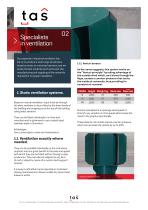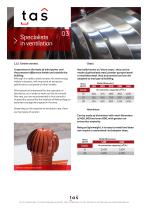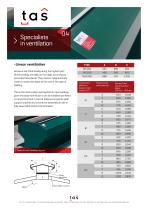Catalog excerpts

Ventilation: Environmental conditions at the workplace are one of the key factors when assessing productivity in any sector. When assessing such conditions, the most important factors are temperature and cleanliness of the atmosphere, as well as the movement of air: 1.- Evacuate heat generated by the industrial process and/or solar radiation. 2- Renew air staled by industrial and/or pollutant effluxes in the building. 3.- Improve humidity control in the building by removing moisture or regulating temperature (condensation). 4.- Extract fumes produced by the industrial activity or fire (safety aerating). Consequently, in order to achieve proper ventilation, the balance between in-coming and out-going air needs to be assessed in view of the volume of the building and of course the nature of business taking place therein. With regard to the amount of air renewal required, the "General Occupational Health & Safety Ordinance" quotes a minimum of 6 air renewals per hour where workers are present. Depending on the company's business and based on the experience of the Union of Profilers and the Arcelor Group as well as our own, we have created a recommendation table with minimum and maximum values that can be adapted to different geographical regions and types of construction. R/h/min R/h/max 1.- As air heats up, it loses density and rises, producing energy, depending on the difference in temperature that pushes it upwards. 2.- The difference in pressure that is created throughout the building top and bottom openings are made is a source of rising energy. Power plants "Aerating systems are based on the principle of natural ventilation". General storage Cinemas/ Textile workshops Retail outlets Animal breeding Light foundries Offices/ Restaurants Paper mills Swimming baths Sports Halls Paintwork-welding shops 3.- If the apparatus is fitted on the rook in the proper way, when the wind blows across it , it causes a counter-pressure that sucks out the air inside the building (Venturi effect). Heavy foundries Mechanical workshop/abattoirs Pol. Ind. Las Quemadas - C/ Imprenta Alborada, parcela 226 - 14014 Córdoba Spain Tél. 957 326 342 Fax. 957 326 438 www.transformadosdelsur.es
Open the catalog to page 1
Our expertise in industrial ventilation has led us to produce a wide range of solutions based on static or motorised aerators, and we study the best model for each particular site, manufacturing and supplying all the materials required for its proper installation. 1. Static ventilation systems. 1.1.1. Venturi aerator. As the name suggests, this system works on the "Venturi principle" by taking advantage of the outside wind which, as it blows through the flaps, causes a counter-pressure that sucks the inside air outwards, thus providing for constant air renewal. (m3/h) MODEL Height Weight...
Open the catalog to page 2
1.1.2. Turbine aerator. It operates on the basis of wind power and the pressure difference inside and outside the building. Although it is really a static aerator, the wind energy makes it dynamic, with improved air extraction performance compared to other models. Wind speed is fundamental for the operation of this device, so in order to work out the air removal flow rate, you are recommended to first consult a trustworthy source like the Institute of Meteorology to ascertain average wind speed in the area. Depending on the required air extraction rate, there are two types of aerator:. ·...
Open the catalog to page 3
Specialists in ventilation · Linear ventilation Aerators are fitted lineally along the highest part of the building, normally on the ridge, according to prescribed standards. They require metal brackets made to match the slope of the roof or the type of building. This is the most widely used system in new buildings given the ease with which it can be installed and fitted on any kind of roof. It can be delivered in pieces (with support bracket and covers) for assembly on site or fully assembled without the brackets. Temperature difference between inlet/ outlet air (Co) 9o Detail of Linear...
Open the catalog to page 4
2. Dynamic ventilation systems. They both work in a similar way to static systems, but are enhanced with a motor which enables the air extraction rates required for the building in question to be achieved, regardless of the weather conditions. Recommended for industrial workshops where the nature of the business indoors calls for rapid and easy air renewal: Presence of fumes, steam, dust or significant heat. Advantages. The benefits and installation tips are the same as for individual static aerators. Optionally, these models can be fitted with either hand-operated or motorised Closing...
Open the catalog to page 5All TRANSFORMADOS Y ACCESORIOS DEL SUR catalogs and technical brochures
-
PROFILE FORMENTERA
2 Pages
-
Metal Roof Flashing
1 Pages
-
PROFILE MALLORCA
2 Pages
-
PROFILE MENORCA
2 Pages
-
CABRERA PROFILE
2 Pages
-
PROFILE DRAGONERA
3 Pages
-
Hopper Box
1 Pages
-
Louvered Fence
1 Pages
-
Perforated Sheet Metal Fence
1 Pages
-
Skylight
5 Pages
-
Downpipes
1 Pages
-
GRILLE-TAS Z ENG
2 Pages
-
ARCHITECTURAL TRAY eng
2 Pages
-
Architectural Cassette eng
1 Pages
















